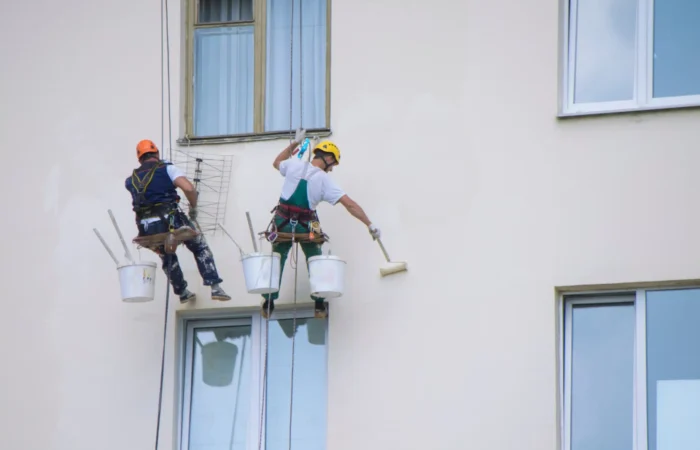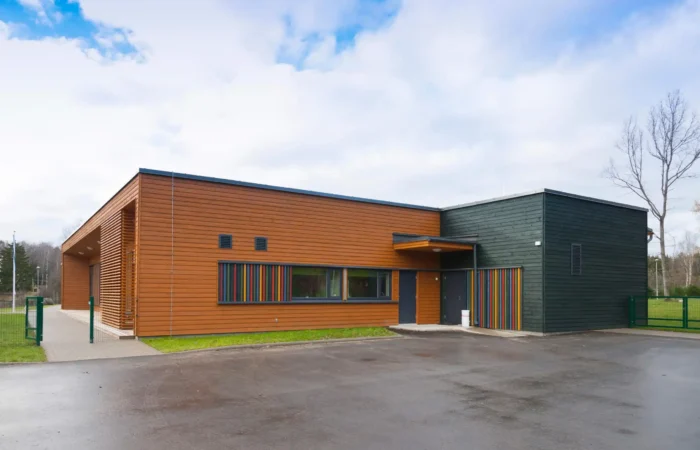
How Often Should The Exterior Of A Commercial Building Be Repainted?
The frequency with which the exterior of a commercial building should be repainted depends on several factors, including the building’s location, the materials used, and the quality of the previous paint job. Generally, a commercial building should be repainted every 5-10 years. Buildings located in harsh climates, such as areas with extreme weather conditions, may require more frequent painting.
Signs Your Commercial Building Needs Repainting
While general guidelines provide a timeframe for repainting, it’s essential to pay attention to specific signs indicating that your commercial building needs a fresh coat of paint. One of the most obvious signs is peeling or cracking paint. These issues not only affect the building’s appearance but also expose the underlying materials to the elements, potentially leading to more severe damage.
Is Your Building Showing Signs of Wear?
- Fading Colour
Gradually, sun and elements may lead to your house’s paint to get faded, and that transform your house into a worn and out-of-date appearance. A noticeable colour fade is an as-clear sign that your building’s exterior needs some maintenance. Periodic appraisal of the appearance of your building will allow you to pay attention to the start of faded colours that can suggest repainting is necessary.
- Cracking or Peeling Paint
These cracks and peels are not just unattractive; they also form a way through which the building can be exposed to rains and other elements that can cause damage. When the paint begins to flake or chip from the walls, timely remedial action is of paramount importance. This way, the minor accidents do not expand into the major structural ones, which results in the preservation of the building both visually and structurally.
- Mold or Mildew Growth
The mold or mildew that shows up on your buildings’ exterior walls are not only a health hazard but also a turn down for your clients or customers. Not only, but these developments signify the fact that the existing paint does not defend moisture anymore which might cause more serious damage if addressed inattentively.
- Water Stains
- Time Since Last Paint Job
Besides the above-mentioned deteriorating features, it’s essential for you to paint your building’s exterior from time to time even if the building is in good condition. As for a time frame its possible to vary based on several factors, but in general a commercial building might need a new paint coat every 5 to 10 years to look its best and protect it from weather conditions.
The Functional Benefits of Repainting Your Building
Beyond just boosting curb appeal, repainting your commercial or strata building brings several functional advantages that can impact its longevity and operational costs. Here are the key benefits.
- Enhanced Protection Against the Elements
- Increased Property Value
Whether it’s the first phone call or a site visit, the impression you make is crucial to attracting commercial real estate clients. Not only does a building always need to be well maintained and painted afresh, but it can also increase property value by 20% or so. Whether it is repainting strata building complexes or standalone commercial properties, this job is an investment for your property’s future.
- Improved Energy Efficiency
- Prevents Structural Damage
Water penetration can lead to even the worst losses of property, such as rot and mould. Regular commercial building repainting involves sealing cracks and gaps on the structure. This way, the building won’t let water come in and penetrate it. Along with the cost of remediation, this preventive measure can save property owners from the need to address structural problems in the future.
- Compliance and Safety
Cost Implications of Regular Repainting
- Initial Costs vs. Long-Term Savings
However, the initial expenditure for the commercial repainting of the buildings may appear to be big, yet long-range economical savings should be considered. A good paint job shield the building from nature, that is why it lowers the related costs which can come from water damage, sun exposure and other naturally factors. The old structure would be able to be used for longer periods of time by carrying out a repaint every 5 to 10 years rather than replacing the building later, thus resulting in saving the money.
- The Impact of Choosing Quality Materials
As far as your building repainting project is concerned, the kind of paint and materials chosen will influence, not only the cost, but durability as well. High grade paints might cost you a fortune at the beginning, but in the long run, they will give you an extended and powerful protection from severe weather conditions. Not only that, they can also be characterized as energy efficiency measures because they are good at reflecting heat and the low temperature results in reduction of cooling cost. The compromise between the cost and the quality is paramount for getting the job done with the paint that looks great for a longer time.
- Timing and Scheduling
- Preventative Maintenance
Frequently Asked Questions
Climatic environments are a major factor in determining the durability of painting jobs. Structures in places with high humidity, excessive heat, or the salt air could need to be recolored more often. It is the sun that brings some problems as this element causes harsher fading of the paint and leads to their faster deterioration. It is significant not only to select appropriate paint formulations for the specific region to achieve the best effect of protecting the paint but also to prolong its life-span.

 Danyelli Rosa2023-08-23On behalf of Peter A. - Committee Member of Birkenhead Quays I have been in the building industry industry for over 50 years, I have never seen a building of this size being completed two months ahead of schedule and under budget. Thanks to Vincent and Yusif they have been amazing. CPR team are true professionals with qualified trade people. Out of 148 apartments not 1 complaint. I would highly recommend them if you want friendly and hassle free servers.
Danyelli Rosa2023-08-23On behalf of Peter A. - Committee Member of Birkenhead Quays I have been in the building industry industry for over 50 years, I have never seen a building of this size being completed two months ahead of schedule and under budget. Thanks to Vincent and Yusif they have been amazing. CPR team are true professionals with qualified trade people. Out of 148 apartments not 1 complaint. I would highly recommend them if you want friendly and hassle free servers. Birkenhead Quays2023-08-21I am the Building Manager for Birkenhead Quays in Drummoyne NSW. I am absolutely thrilled to share my incredible experience with CPR! Every aspect of their work, from the initial consultation to the final brushstroke, exuded a sense of excellence. The attention to detail they displayed was remarkable; it was evident that they took great pride in delivering flawless results. What truly sets CPR apart is their commitment to understanding and meeting their clients' needs. They took the time to listen to our vision and preferences, incorporating them seamlessly into their approach. The final result was a masterpiece that exceeded all our expectations. Furthermore, their professionalism and punctuality were second to none. Deadlines were not only met but surpassed, showcasing their dedication to providing a seamless and stress-free experience. Their team worked efficiently and neatly, ensuring that our building was left even more immaculate than when they arrived. CPR is a shining beacon of excellence. If you're looking for a painting company that delivers unwavering professionalism, and a truly remarkable experience, look no further. I am beyond grateful for their exceptional work and can't recommend them highly enough. A big thank you to Vicente, Hussain, Namat, Yusif, Dinesh and Mark on this project. Sincerely, Danyelli Rosa - Birkenhead Quays
Birkenhead Quays2023-08-21I am the Building Manager for Birkenhead Quays in Drummoyne NSW. I am absolutely thrilled to share my incredible experience with CPR! Every aspect of their work, from the initial consultation to the final brushstroke, exuded a sense of excellence. The attention to detail they displayed was remarkable; it was evident that they took great pride in delivering flawless results. What truly sets CPR apart is their commitment to understanding and meeting their clients' needs. They took the time to listen to our vision and preferences, incorporating them seamlessly into their approach. The final result was a masterpiece that exceeded all our expectations. Furthermore, their professionalism and punctuality were second to none. Deadlines were not only met but surpassed, showcasing their dedication to providing a seamless and stress-free experience. Their team worked efficiently and neatly, ensuring that our building was left even more immaculate than when they arrived. CPR is a shining beacon of excellence. If you're looking for a painting company that delivers unwavering professionalism, and a truly remarkable experience, look no further. I am beyond grateful for their exceptional work and can't recommend them highly enough. A big thank you to Vicente, Hussain, Namat, Yusif, Dinesh and Mark on this project. Sincerely, Danyelli Rosa - Birkenhead Quays Judy P2023-07-26High quality work, customer-focused service, impressive outcomes. Project Manager Vicente Barba and his team were professional and responsive.
Judy P2023-07-26High quality work, customer-focused service, impressive outcomes. Project Manager Vicente Barba and his team were professional and responsive. Fran Lubotzky2023-03-10This company is outstanding!! So professional, such great communication, such clean, tidy and brilliant work painting our very high and large building with next to no disruption, hassle or inconvenience. I highly recommend this company. Fran
Fran Lubotzky2023-03-10This company is outstanding!! So professional, such great communication, such clean, tidy and brilliant work painting our very high and large building with next to no disruption, hassle or inconvenience. I highly recommend this company. Fran Ross Elsley2022-08-01We live by the sea and CPR completed painting of the exterior of our Strata Building in 2015. Seven (7) years later, it still looks great.
Ross Elsley2022-08-01We live by the sea and CPR completed painting of the exterior of our Strata Building in 2015. Seven (7) years later, it still looks great. Andrew Digby2022-06-23Cannot fault this company. They were professional and polite and keep the occupants well informed as to their activities! Our building looks like new again. The employees are friendly and helpful.
Andrew Digby2022-06-23Cannot fault this company. They were professional and polite and keep the occupants well informed as to their activities! Our building looks like new again. The employees are friendly and helpful. Bevo2022-06-19We have just recently had our building facade painted by the team from CPR. The building was built in 1969 and is 8 stories in height - the abseiling worked perfectly for the job. Over 30 years I have been involved in many major projects and the guys from CPR were delightful to work with. The team was led by Vicente and nothing was a problem - the guys were always there to help. The response from other residents in the building is the same - everyone thought all the guys on the job were very friendly, punctual, polite and super obliging. The communications throughout the job was always open with weekly site meetings. We have had positive comments from many of our neighbours about the fantastic result and I would not hesitate to recommend CPR. Katrina
Bevo2022-06-19We have just recently had our building facade painted by the team from CPR. The building was built in 1969 and is 8 stories in height - the abseiling worked perfectly for the job. Over 30 years I have been involved in many major projects and the guys from CPR were delightful to work with. The team was led by Vicente and nothing was a problem - the guys were always there to help. The response from other residents in the building is the same - everyone thought all the guys on the job were very friendly, punctual, polite and super obliging. The communications throughout the job was always open with weekly site meetings. We have had positive comments from many of our neighbours about the fantastic result and I would not hesitate to recommend CPR. Katrina Renee Goossens2022-05-24Our experience with Facade upgrade specialists was excellent. The attention to detail wonderful. The entire performance was faultless. The team worked diligently with care and precision as they quietly abseiled down our building. It was a long job over two buildings but it was noteworthy that Abdul and his team worked long hours here. There were no raised voices and than goodness no loud radios. For fifteen months, partly due to Covid, our building seemed to be under siege. Scaffolding had been required by the noisy team who needed to remove then our combustible cladding. Having your Facade team was sheer delight after what had previously been a rude and noisy ordeal. Bravo to you all. Thanks for your good work.
Renee Goossens2022-05-24Our experience with Facade upgrade specialists was excellent. The attention to detail wonderful. The entire performance was faultless. The team worked diligently with care and precision as they quietly abseiled down our building. It was a long job over two buildings but it was noteworthy that Abdul and his team worked long hours here. There were no raised voices and than goodness no loud radios. For fifteen months, partly due to Covid, our building seemed to be under siege. Scaffolding had been required by the noisy team who needed to remove then our combustible cladding. Having your Facade team was sheer delight after what had previously been a rude and noisy ordeal. Bravo to you all. Thanks for your good work. Margaret Freemantle2022-05-10This company is so professional and passionate about their work, as well as being obliging and helpful. A pleasure to have this team painting our building. With thanks.
Margaret Freemantle2022-05-10This company is so professional and passionate about their work, as well as being obliging and helpful. A pleasure to have this team painting our building. With thanks.



